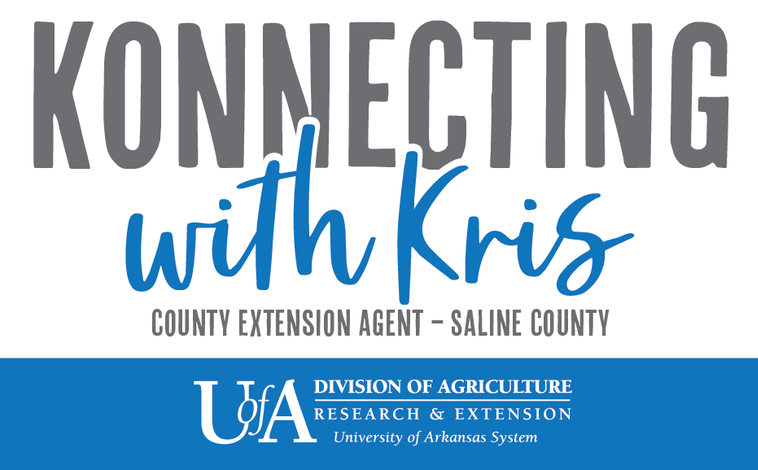Building a Healthy Plate
Contact
Kris Boulton
Phone: (501) 303-5672
Email: kboulton@uada.edu

Office:
University of Arkansas System Division of Agriculture
Cooperative Extension Service
1605 Edison Ave.
Benton, AR 72015
University of Arkansas System Division of Agriculture
Cooperative Extension Service
1605 Edison Ave.
Benton, AR 72015

Konnecting with Kris Blog
Connect with Saline County FCS agent Kris Boulton.
Building a Healthy Plate
Tip 1 Build a Healthy Plate
Before you eat, think about what goes on your plate or in your cup or bowl. Foods like vegetables, fruits, whole grains, low-fat dairy products, and lean protein foods contain the nutrients you need without too many calories. Try some of these options.
Make half your plate fruits and vegetables.
- Eat red, orange, and dark-green vegetables, such as tomatoes, sweet potatoes, and broccoli, in main and side dishes.
- Eat fruit, vegetables, or unsalted nuts as snacks—they are nature’s original fast foods. Switch to skim or 1% milk.
- They have the same amount of calcium and other essential nutrients as whole milk, but less fat and calories.
- Try calcium-fortified soy products as an alternative to dairy foods.
Make at least half your grains whole.
- Choose 100% wholegrain cereals, breads, crackers, rice, and pasta.
- Check the ingredients list on food packages to find whole-grain foods. Vary your protein food choices.
- Twice a week, make seafood the protein on your plate.
- Eat beans, which are a natural source of fiber and protein.
- Keep meat and poultry portions small and lean.
Tip 2 Cut back Foods High in solid Fats, added Sugars, and Salt
Eat fewer foods that are high in solid fats.
- Make major sources of saturated fats—such as cakes, cookies, ice cream, pizza, cheese, sausages, and hot dogs—occasional choices, not everyday foods.
- Select lean cuts of meats or poultry and fat-free or low-fat milk, yogurt, and cheese.
- Switch from solid fats to oils when preparing food
Choose foods and drinks with little or no added sugars.
- Drink water instead of sugary drinks. There are about 10 packets of sugar in a 12-ounce can of soda. Select fruit for dessert.
- Eat sugary desserts less often. Choose 100% fruit juice instead of fruit-flavored drinks.
Look out for salt (sodium) in foods you buy - it all adds up.
- Compare sodium in foods like soup, bread, and frozen meals—and choose the foods with lower numbers.
- Add spices or herbs to season food without adding salt.
Tip 3 Eat the Right number of Calories for Your Size
- Enjoy your food but eat less.
- Get your personal daily calorie limit at www.ChooseMyPlate.gov and keep that number in mind when deciding what to eat.
- Think before you eat…is it worth the calories?
- Avoid over-sized portions. Use a smaller plate, bowl, and glass. Stop eating when you are satisfied, not full.
- Cook more often at home, where you are in control of what’s in your food.
- If you drink alcoholic beverages, do so sensibly—limit to 1 drink a day for women or to 2 drinks a day for men.
Tip 4 Be Physically Active - your way
- Pick activities that you like and start by doing what you can, at least ten minutes at a time. Every bit adds up, and the health benefits increase as you spend more time being active.